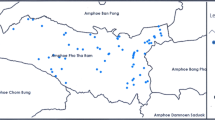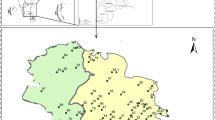Abstract
Nitrate pollution in rivers, lakes, shallow groundwater, and even deep groundwater occurs in many parts of the world. And, it’s essential to assessing the relationship between nitrate pollution and human health, which is called human health risk assessment (HHRA). In this paper, groundwater samples were collected for their nitrate content in a typical karst hydrogeological unit in East China during the wet and dry seasons. Then, a human health risk assessment was conducted using the four-step risk assessment process developed by the US Environmental Protection Agency (USEPA), which aimed to determine the potential risk posed to human health by nitrate in the groundwater. To make the assessment more authentic and objective, the drinking water and dermal contact exposure pathways were considered, and the people were divided into four groups, including infants (0~6 months), children (7 months~17 years old), females (18 years and older), and males (18 years and older), in the wet and dry seasons to determine the impacts of the exposure pathway, age, sex, and precipitation period. The results indicated that more than half of the groundwater samples exceeded 10 mg/L (measured as nitrogen), which is the drinking water standard of China. The children and infants had greater health risks than the adults at the same groundwater nitrate concentration, and those two groups need to be paid more attention; the adult females had a greater health risk than the adult males in the two precipitation periods, which shows that the order of the health risk was infants ˃ children ˃ adult females ˃ adult males. In addition, the value of the hazard quotient (HQ) and the area of the adverse effects were both higher in the wet season than in the dry season, which explains that precipitation can affect the human health risk as well. The HQ caused by the drinking water exposure pathway was much higher than that caused by the dermal contact exposure pathway. This study can provide information for more effective and reasonable decisions to city managers for groundwater nitrate pollution prevention.











Similar content being viewed by others
References
Bois DD, Bois EFD (1916) A formula to estimate approximate surface area, if height and weight are known. Arch Intern Med 17:863–871
Bosch HM, Rosenfield AB, Huston R, Shipman HR, Woodward FL (1950) Methemoglobinemia and Minnesota well supplies. Journal 42(2):161–170
Boyd E (1936) The growth of the surface area of the human body. J Anat 70(Pt4):586
Bukowski J, Somers G, Bryanton J (2001) Agricultural contamination of groundwater as a possible risk factor for growth restriction or prematurity. J Occup Environ Med 43(4):377–383
Health Canada (2019) Guidelines for Canadian drinking water quality—summary table. Water and air quality bureau. Healthy Environments and Consumer Safety Branch, Health Canada, Ottawa
CDC (Centers for Disease Control and Prevention) (1996) Spontaneous abortions possibly related to ingestion of nitrate-contaminated well water--LaGrange County, Indiana, 1991-1994. Morbidity and Mortality Weekly Report (MMWR) 45(26):569–572
Cedergren MI, Selbing AJ, Löfman O, Källen BAJ (2002) Chlorination byproducts and nitrate in drinking water and risk for congenital cardiac defects. Environ Res 89(2):124–130
Chen J, Qian H, Gao YY, Li XY (2017a) Human health risk assessment of contaminants in drinking water based on triangular fuzzy numbers approach in Yinchuan City, northwest China. Expos Health 10(3):155–166
Chen J, Qian H, Wu H (2017b) Nitrogen contamination in groundwater in an agricultural region along the New Silk Road, northwest China: distribution and factors controlling its fate. Environ Sci Pollut Res 24:13154–13167
Chen J, Wu H, Qian H (2016) Groundwater nitrate contamination and associated health risk for the rural communities in an agricultural area of Ningxia, northwest China. Expos Health 8(3):349–359
Chen J, Wu H, Qian H, Gao Y (2017c) Assessing nitrate and fluoride contaminants in drinking water and their health risk of rural residents living in a semiarid region of northwest China. Expos Health 9(3):183–195
Cheng SC, Lu ZQ, Song YF, Zhang Q (2016) Nitrate pollution situation and source tracing of fissure karst groundwater in some area, Jinan. Geol Chem Miner 38(4):226–231 (in Chinses)
Chenini I, Ben Mammou A, Turki MM (2008) Groundwater resources of a multi-layered aquiferous system in arid area: data analysis and water budgeting. Int J Environ Sci Te 5(3):361–374
Dai RX, Hao XY (2015) Analysis and suggestion on fertilizers usage in China. Agricultural Outlook (9):77-80(in Chinses)
Gehan EA, George SL (1970) Estimation of human body surface area from height and weight. Cancer Chemother Rep 54(4):225–235
Guo Y, Qin DJ, Li L, Sun J, Li FL, Huang JW (2019) Recharge of river water to karst aquifer determined by hydrogeochemistry and stable isotopes. Water 11(479)
Guo Y, Qin DJ, Li L, Sun J, Li FL, Huang JW (2019) A complicated karst spring system: identified by karst springs using water level, hydrogeochemical, and isotopic data in Jinan, China. Water 11(947)
Jones RR, Weyer PJ, DellaValle CT, Robien K, Cantor KP, Krasner S, Beane Freeman LE, Ward MH (2017) Ingested nitrate, disinfection by-products, and kidney cancer risk in older women. Epidemiology 28(5):703–711
Kazakis N, Voudouris KS (2015) Groundwater vulnerability and pollution risk assessment of porous aquifers to nitrate: modifying the DRASTIC method using quantitative parameters. J Hydrol 525:13–25
Knobeloch L, Salna B, Hogan A, Postle J, Anderson H (2000) Blue babies and nitrate-contaminated well water. Environ Health Perspect 108(7):675–678
Kobayashi J (2017) Effect of diet and gut environment on the gastrointestinal formation of N-nitroso compounds: a review. Nitric Oxide-Biol Ch 73:66–73
Liu T, Xu SR, Lu SY, Qin P, Bi B, Ding HD, Liu Y, Guo XC, Liu XH (2019) A review on removal of organophosphorus pesticides in constructed wetland: performance, mechanism and influencing factors. Sci Total Environ 651:2247–2268
Macilwain C (1995) US report raises fears over nitrate levels in water. Nature 377:4–4
Meng Y, Liu XH, Lu SY, Zhang TT, Jin BH, Wang Q, Tang ZR, Liu Y, Guo XC, Zhou JL, Xi BD (2019) A review on occurrence and risk of polycyclic aromatic hydrocarbons (PAHs) in lakes of China. Sci Total Environ 651:2497–2506
Ministry of Environmental Protection of the People’s Republic of China (2013) Exposure factors handbook of Chinese population. Environmental Science Press (in Chinses)
NAS (National Academy of Sciences) (1981) The health effects of nitrate, nitrite and N-nitroso compounds. National Academy Press, Washington, DC
NBS (National Bureau of Statistics of China) (2015) China statistical year book. China Statistics Press, Beijing
NHMRC, NRMMC (2011) Australian drinking water guidelines paper 6 national water quality management strategy. National Health and Medical Research Council. National Resource Management Ministerial Council, Canberra
NRC (National Research Council) (1983) Risk assessment in the federal government: managing the process. National Academies Press, Washington, DC
Ohore OE, Addo FG, Zhang SH, Han NN, Anim-Larbi K (2018) Distribution and relationship between antimicrobial resistance genes and heavy metals in surface sediments of Taihu Lake, China. J Environ Sci 77:323–335
Rajas Fabro AY, Pacheco Avila JG, Esteller Alberich MV, Cabrera Sansores SA, Camargo-Valero MA (2015) Spatial distribution of nitrate health risk associated with groundwater use as drinking water in Merida, Mexico. Appl Geogr 65:49–57
Skold ACD, Klein R (2011) Methemoglobinemia: pathogenesis, diagnosis, and management. South Med J 104(11):757–761
Su XS, Wang H, Zhang YL (2013) Health risk assessment of nitrate contamination in groundwater: a case study of an agricultural area in northeast China. Water Resour Manag 27(8):3025–3034
USEPA (US Environmental Protection Agency) (1989) Risk assessment guidance for Superfund, Volume I: Human Health Evaluation Manual (Part A). Washington, DC. EPA/540/1-89/002
USEPA (US Environmental Protection Agency) (1991) Integrated risk information system (IRIS) chemical assessment summary: Nitrate, CASRN 14797-55-8
USEPA (US Environmental Protection Agency) (1992) Guidelines for exposure assessment. Risk Assessment Forum, Washington, DC. EPA/600/Z-92/001
USEPA (US Environmental Protection Agency) (2000) Risk characterization handbook. Washington, DC. EPA/100/B-00/002
USEPA (US Environmental Protection Agency) (2001) Integrated risk information system (IRIS): risk assessment guidance for Superfund volume III: part A, process for conducting probabilistic risk assessment. Washington DC. EPA/540/R-02/022
USEPA (US Environmental Protection Agency) (2002) National recommended water quality criteria: 2002. Office of Water & Office of Science and Technology, Washington, DC. https://www.epa.gov/wqc/national-recommended-water-quality-criteria
USEPA (US Environmental Protection Agency) (2004) Risk assessment guidance for Superfund, Volume I: Human Health Evaluation Manual (Part E, Supplemental Guidance for Dermal Risk Assessment) Final. Washington DC. EPA/540/R-99/005
USEPA (US Environmental Protection Agency) (2005) Guidelines for carcinogen risk assessment. Risk Assessment Forum, Washington, DC. EPA/630/P-03/001F
USEPA (US Environmental Protection Agency) (2006). A framework for assessing health risks of environmental exposures to Children. Washing DC. EPA/600/R-05/093F
USEPA (US Environmental Protection Agency) (2011) Exposure factors handbook: 2011 Edition. Office of Research and Development, Washington, DC. EPA/600/R-090/052F
Ward MH, Jones RR, Brender JD, Kok TM, Weyer PJ, Nolan BT, Villanueva CM, Breda SG (2018) Drinking water nitrate and human health: an update review. Int J Environ Res Public Health 15(7):1157
WHO (World Health Organization) (2017) Guidelines for drinking-water quality: fourth edition incorporating the first addendum. Geneva: World Health Organization Licence: CC BY-NC-SA 3.0 IGO
Han XR (2015) Karst hydrogeology. Science Press, Beijing (in Chinese)
Yang M, Fei Y, Ju Y et al (2012) Health risk assessment of groundwater pollution—a case study of typical city in North China plain. J Earth Sci 23(3):335–348
Zhai Y, Lei Y, Wu J, Teng Y, Wang J, Zhao X, Pan X (2016) Does the groundwater nitrate pollution in China pose a risk to human health? A critical review of published data. Environ Sci Pollut Res 24:1–14
Zhang X, Davidson EA, Mauzerall DL, Searchinger TD, Dumas P, Shen Y (2015) Managing nitrogen for sustainable development. Nature 528:51–59
Zhang ZX, Wang WP, Qu SS, Huang Q, Liu S, Xu XQ, Ni LD (2018) A new perspective to explore the hydraulic connectivity of karst aquifer system in Jinan spring catchment, China. Water 10(1368)
Zheng BH, Wang LP, Lei K, Nan BX (2016) Distribution and ecological risk assessment of polycyclic aromatic hydrocarbons in water, suspended particulate matter and sediment from Daliao River estuary and the adjacent area, China. Chemosphere 149:91–100
Acknowledgments
This work was supported by the National Natural Science Foundation of China (41772257,41472216), the Research Project of Shandong Provincial Bureau of Geology & Mineral Resources (KY2018003; KY201933), and the Open Fund in 2019 from the Key Laboratory of Groundwater Resources and Environment of Shandong Provincial Bureau of Geology & Mineral Resources. We are also grateful to valuable comments and suggestions given by the editors and the reviewers.
Author information
Authors and Affiliations
Corresponding author
Additional information
Responsible editor: Philippe Garrigues
Publisher’s note
Springer Nature remains neutral with regard to jurisdictional claims in published maps and institutional affiliations.
Rights and permissions
About this article
Cite this article
Gao, S., Li, C., Jia, C. et al. Health risk assessment of groundwater nitrate contamination: a case study of a typical karst hydrogeological unit in East China. Environ Sci Pollut Res 27, 9274–9287 (2020). https://doi.org/10.1007/s11356-019-07075-w
Received:
Accepted:
Published:
Issue Date:
DOI: https://doi.org/10.1007/s11356-019-07075-w




